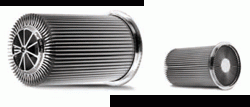Sintered metal filters – a speedy solution for cleaner cities
April 11, 2012
The declared objective of the European Air Quality Directive (199/30/EC) is to maintain ambient air quality where it is good, and improve it in other cases by applying limit values and alarm thresholds for the concentrations of certain airborne pollutants, in particular from road traffic.
At the present time, the permitted annual averages are 40 micrograms per cubic metre of air for nitrogen oxides and 20 micrograms for particulate matter emitted from diesel engines. If the limits are exceeded, the authorities in the cities or areas in question are required by law to impose measures that will effectively reduce the pollutant concentrations in the air in order to protect health. For example, from early February 2012 in London, commercial vehicles (including buses) that do not comply with the new standards have had to pay a daily charge of £200 or risked facing a penalty of £1000 for non-compliance.
HJS Emission Technology from Menden, Germany, is one of Europe’s leading manufacturers of emission control equipment including its HJS SMF® (sintered metal filters) used in its Direct Fit kits – direct replacement systems for OE equipment exhausts – or as Flex Fit systems which can be adapted to any commercial vehicle such as LGVs, HGVs, coaches and buses as well as a wide range of non-road mobile machinery and stationary applications.
The sintered metal filters are said to provide a clear advantage over technologies which still use difficult to maintain ceramic substrates. The typical cleaning interval for an HJS SMF® to remove ash is 120,000 miles whereas most ceramic type filters could be on their third clean by this time.
The HJS SMF® (sintered metal filters) work by feeding the hot exhaust gases from the engine – which contain soot particles – into the filter housing and through the sintered metal filter. The gaseous components flow through the microscopic pores of the filter pockets; the soot particles, including the ultra-fine particles, are trapped on the surface and deposited on the individual filter pockets. Regeneration (cleaning) of the filter starts when the exhaust gas temperature reaches roughly 200°C. The nitrogen dioxide (NO2) formed with the help of the oxidation catalytic converter (aka oxi-cat) comes into contact with the soot deposited on the filter pockets, causing the soot particles to oxidise and degrade; the NO2 is then reduced to nitrogen oxide (NO).
This chemical process is repeated so that the HJS City-Filter® regenerates itself continuously, requiring no additional regeneration aids, such as assistance from the engine management system.
Posted by: Paul Whittaker, Editor ipmd.net, [email protected]
News | Articles | Market reviews | Search directory | Subscribe to e-newsletter
















